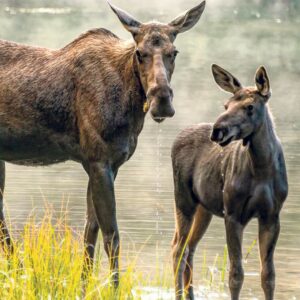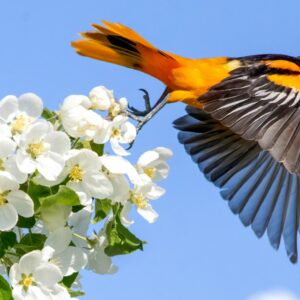A Geography of Hope for Biodiversity in the Americas – A conservation initiative joins sites and organizations working for bird conservation
A Geography of Hope for Biodiversity in the Americas
A conservation initiative joins sites and organizations working for bird conservation
May 4, 2010 (Ottawa & Port Rowan) – Bird species are getting a helping hand from an international program that connects vital habitats here in Canada with other sites across the Western Hemisphere. And, in a first for the Americas, BirdLife International’s Important Bird Areas (IBA) program today launched a roadmap for conservation, the Americas IBA Directory. This publication identifies 2,345 top-priority conservation sites in all 57 countries and territories. The IBA program not only provides a blueprint for decision makers to make informed decisions on habitat protection and restoration but is already helping the conservation of both threatened and common species as well as a wealth of wider biodiversity.
“IBAs are becoming a formidable tool to help governments, the private sector, investment banks and donor organizations to direct conservation funding towards clearly defined priorities,” said Dr Marco Lambertini, Chief Executive of BirdLife International. “Many of the people that live in and around IBAs also depend on them for natural resources and ecosystem services, such as protection of water sources and driving sustainable economic development.”
IBAs cover almost 8% of the land area of the Americas, including nearly 600 IBAs in Canada. These include well-known migratory bird staging areas such as Point Pelee National Park in Ontario, and British Columbia’s Boundary Bay, a provincially-designated wildlife conservation area. Nearly two thirds of IBAs in the Western Hemisphere receive only partial or no protection, sites such as key grassland areas in the Milk River area in southern Alberta.
The program has brought together thousands of dedicated supporters from across the hemisphere, representing a sizable network of 20 national NGOs in the Americas and at least 150 other collaborating organizations, and is already delivering tangible benefits and attracting greater investment in biodiversity conservation.
Many bird species such as Red-tailed Hawk, Semipalmated Plover, Long-billed Curlew, Western Sandpiper, and Canada Warbler, need a network of sites covering their breeding grounds, migration stopover sites and wintering areas.
“The islands of Cuba and Hispaniola are of great importance as stopover or wintering grounds for migratory birds that breed in Canada, including at-risk species such as Bicknell’s Thrush,” said Ian Davidson, Executive Director of Nature Canada. “It’s truly one of the world’s biodiversity hotspots, but it’s also an area in the Americas that is greatly affected by poverty.”
That’s why Nature Canada has joined with BirdLife partners in Cuba, the Dominican Republic and Haiti to help local families move away from slash and burn subsistence living to self-sufficiency based on renewable silviculture and traditional horticulture. Promoting sustainable livelihoods has helped reduce pressure on some of the region’s few remaining forest habitats.
“Improving our understanding, appreciation and conservation of wild birds and their habitats is the core of Bird Studies Canada’s mission and also represents a perfect fit with the Important Bird Areas Program,” noted George Finney, President of Bird Studies Canada. “From breeding grounds in Canada, to wintering sites in the south, and all points in between, it is imperative that we understand what is happening to bird populations and the forces that drive change. Bird Studies Canada is proud to work closely with our international partners on this issue, so that better management decisions and conservation actions can be taken.”
As an example of how Bird Studies Canada and Nature Canada are drawing on their respective strengths to improve conservation outcomes, it is worth looking at recent work in Atlantic Canada, where the Bicknell’s Thrush is one of Bird Studies Canada’s focal species of study. Analyses of habitat associations with nesting habitat have led to specific recommendations to forestry companies and regulators on how the species could be protected in Canada.
Bird Studies Canada and Nature Canada are leading a national effort to ramp up conservation, advocacy and science work at Important Bird Areas across Canada. Along with a network of regional partners and a cadre of dedicated volunteers – known as IBA Caretakers – the groups are working to increase the profile of IBAs in decision-making circles and to gather defensible bird population data that can be used to track changes over time.
“Important Bird Areas in the Americas contain habitat that is critically important not only for migratory and resident birds, but for the countless other life forms they preserve,” Margaret Atwood and Graeme Gibson, Joint Honorary Presidents of BirdLife’s Rare Bird Club, wrote in the foreword of the Americas IBA Directory. “If we could look down on these havens from above, as the birds themselves do, we’d view them as a cartography of hope. As long as these oases exist, saving the birds is still possible.”
For More Information, Contact:
Ian Davidson
Executive Director, Nature Canada
idavidson@naturecanada.ca
(613) 299-6973
Andrew Couturier
Senior Analyst, Landscape Ecology and Conservation
Bird Studies Canada
acouturier@bsc-eoc.org
(519) 586-3531 ext. 131
Further Information
www.ibacanada.ca
Background
BirdLife International (www.birdlife.org) is a global partnership of more than 100 conservation organizations working together to promote sustainable living as a means to conserve biodiversity. Bird Studies Canada and Nature Canada are the Canadian co-partners in BirdLife International.
Bird Studies Canada (BSC) administers regional, national, and international programs that advance the understanding, appreciation, and conservation of wild birds and their habitats. BSC is Canada’s national body for bird research and monitoring, and is a non-governmental charitable organization. Visit www.birdscanada.org to learn more.
Nature Canada (www.naturecanada.ca) is a national non-profit that works with local groups in Canada to protect bird habitat, counsels policy-makers to ensure strong bird protection laws and regulations exist nationally, and collaborates with BirdLife partners in other countries to save migratory bird populations throughout the hemisphere.
Americas IBA Directory
The Americas IBA directory results from a joint effort between all the countries in the Western Hemisphere and includes a summary of 2345 Important Bird Areas, covering an area of 3,284,602 km2, or 7.9% of the region’s area. Thirty-one percent of IBAs in the Americas are totally protected, 22% are partially protected and the rest lack formal protection status, or are without information.
The Americas is one of the most important regions for bird conservation, given that it holds almost 40% of the world’s threatened species (11% of the region’s birds are threatened). Principal threats come from agriculture, unsustainable use of natural resources (e.g. logging and hunting) and invasive species.
The IBA Program
BirdLife’s Important Bird Area Program is a global initiative focused on the identification, documentation and conservation of a global network of critical sites for bird and other biodiversity. IBAs are identified at national level with locally compiled information, using internationally standardized scientific criteria. Currently, more than 10,000 IBAs exist around the world.
The IBA program in the Americas started in 1995 with the aim of supporting national conservation strategies and protected area programs by identifying priority areas for conservation; identifying the most urgent actions to be implemented in each, providing goals for civil society conservation initiatives and promoting the implementation of regional and international environmental agreements.



